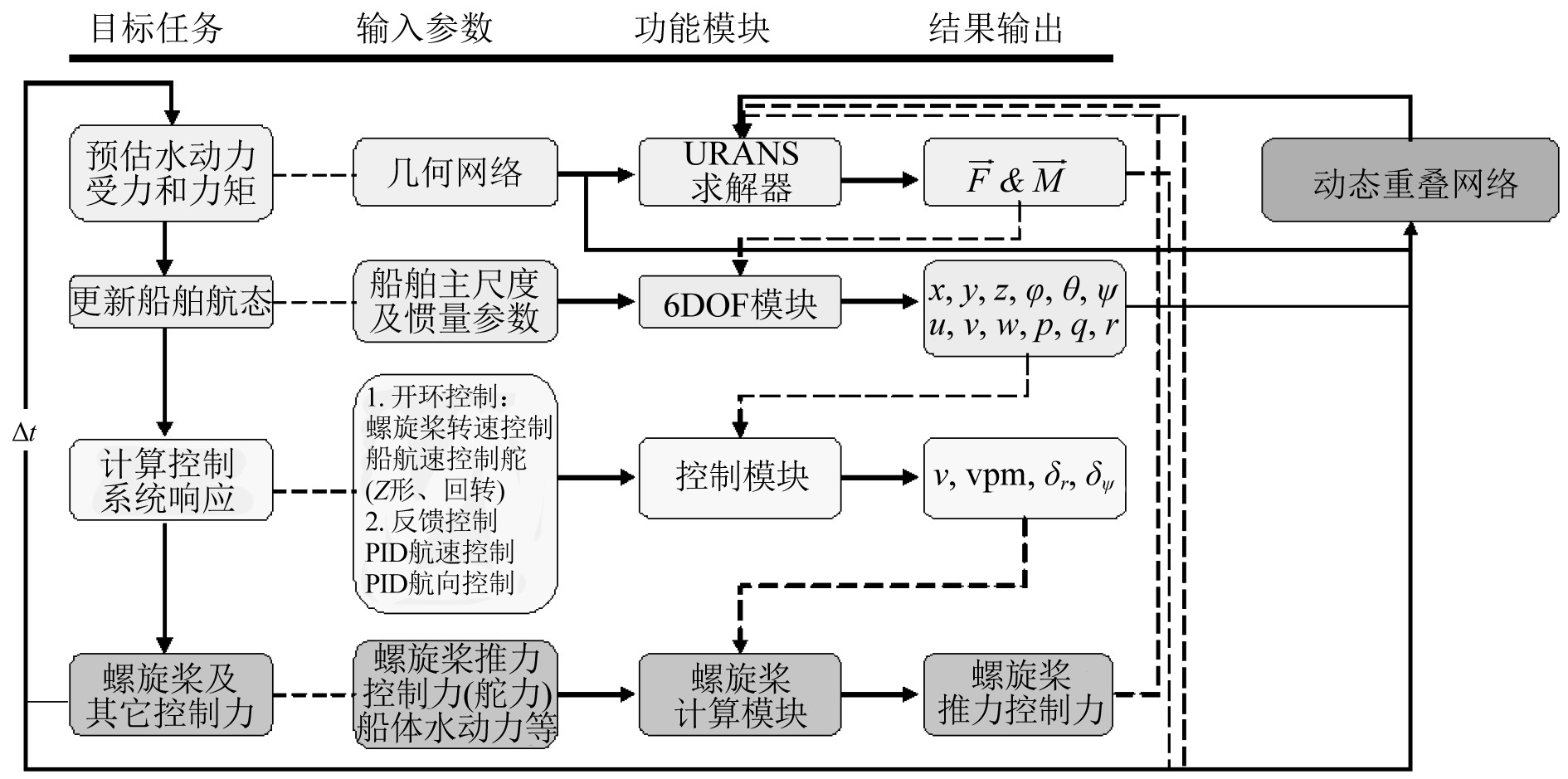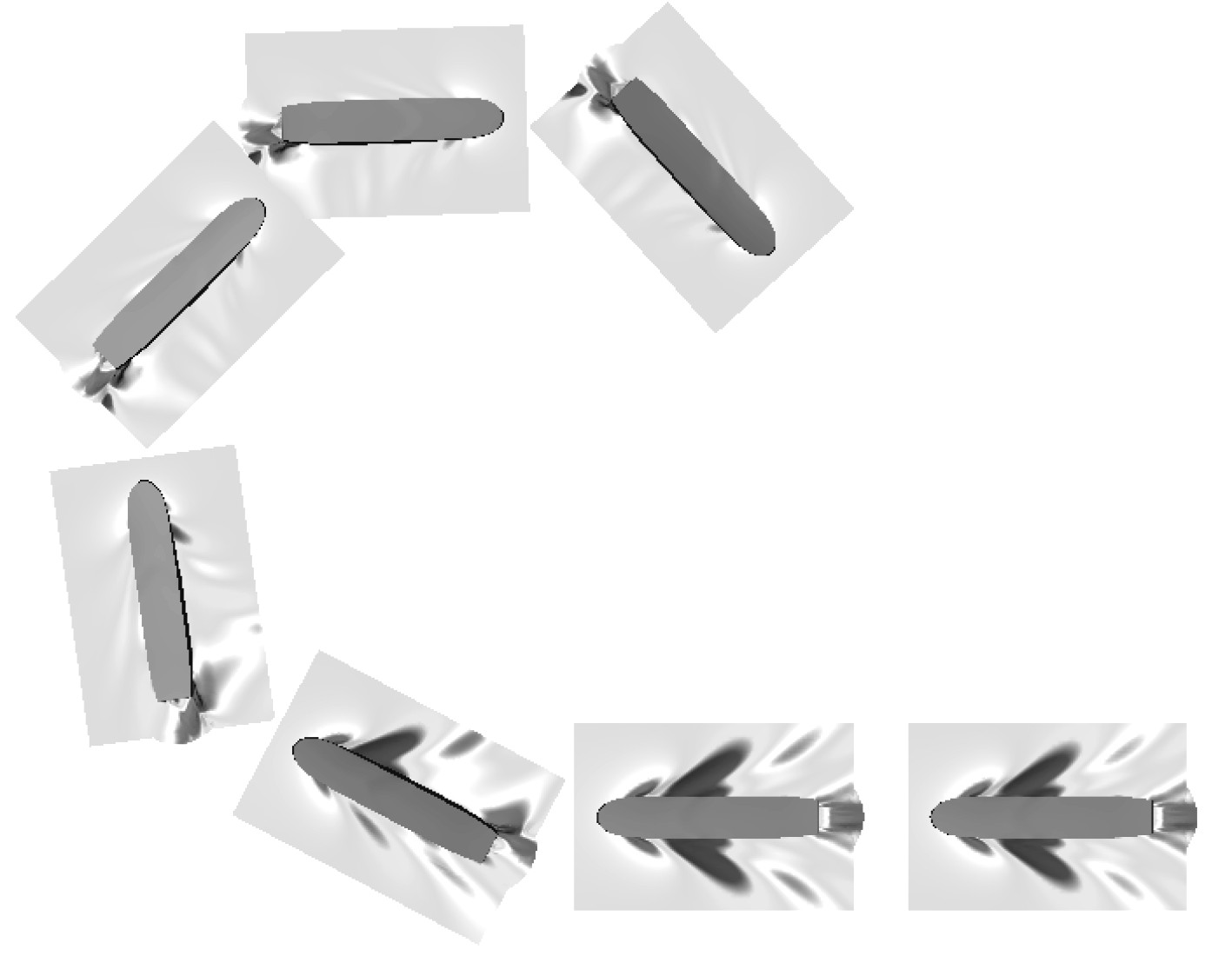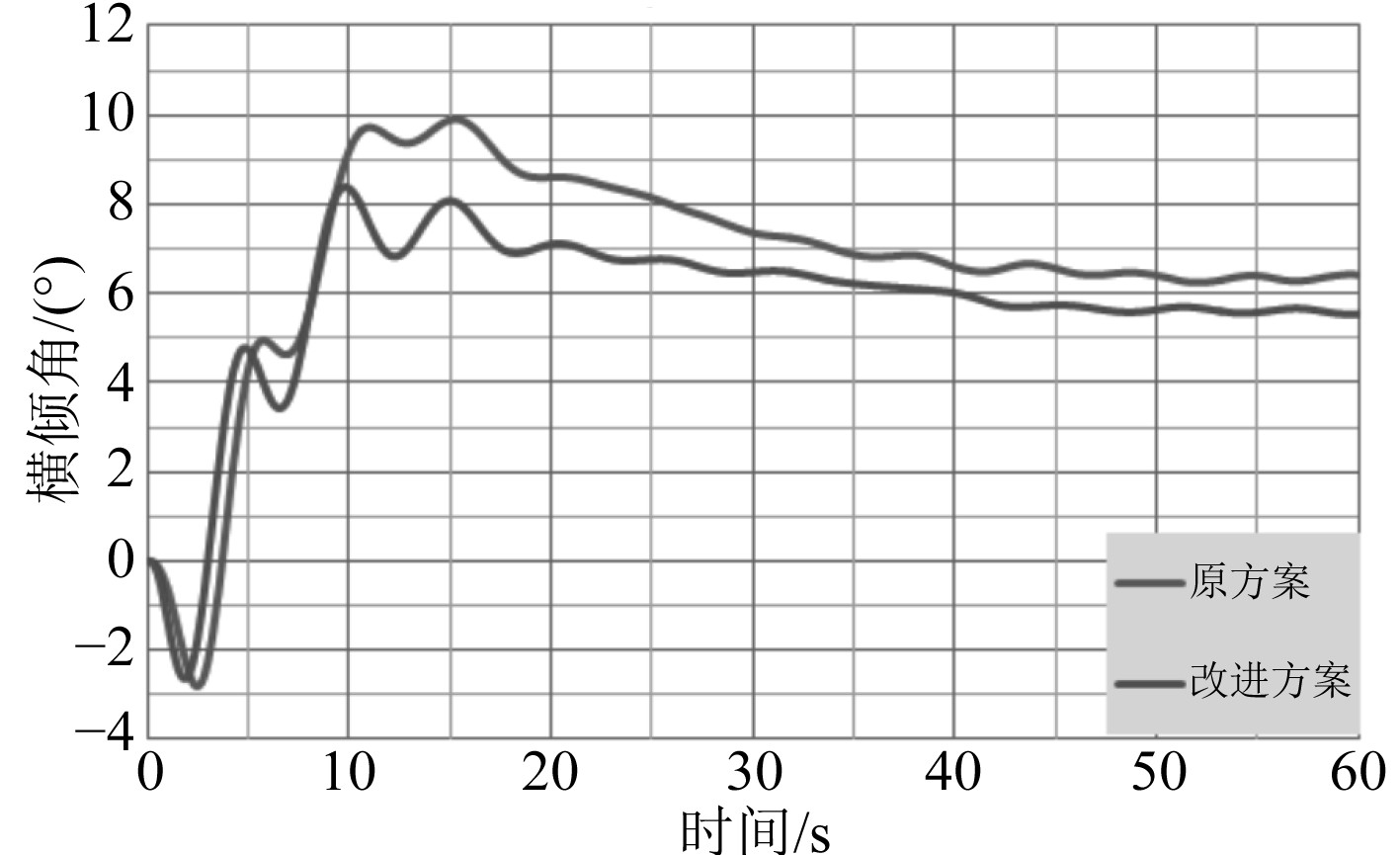2. 深海技术科学太湖实验室,江苏 无锡 214082
2. Taihu Laboratory of Deep-sea Technology Science, Wuxi 214082, China
操纵性对船舶在海上航行十分重要,具备优良操纵性能的船舶其安全性能、作业能力等将得到提升。当前,针对船舶操纵性能的预报主要有操纵性水池模型试验以及CFD数值模拟等2种主流的预报方式,水池模型试验的研究主要集中在约束模试验,包括静态拖航试验、动态平面运动机构试验以及旋转试验[1 − 2]。程捷等[3]通过商业软件Fluent 提供的动网格功能,对 DTMB5415模型的平面运动机构试验中的动态纯横荡和纯摇首试验进行了数值模拟,计算得到的侧向力及转首力矩的变化与实验结果趋势一致,但预报精度有待提高。针对CFD的自航模试验还主要集中在预报方法等的研究上,Broglia 等[4]采用改进的螺旋桨体积力模型,进行了单独舵和双舵情况下的双桨推进船舶自由回转试验数值模拟,基于体积力模型的操纵运动数值模研究大多依然处于理论研究阶段,公开的工程应用报道较少。
本文首先对基于自航模的船舶操纵性能数值预报方法进行了阐述,包括数值模拟方法、湍流模型、自由液面模型、网格划分方式以及体积力模型等,接着针对某300 t海洋调查船实船海试过程中出现回转横倾过大问题开展其回转性能数值研究,对影响回转性能的船底呆木进行改进设计。通过对比分析可知在不改变船体构型的前提下,呆木改进方案下的回转横倾得到了大幅改善,避免了回转过程中横倾角过大问题,安全性得到保障,为该船的顺利交付提供了技术支撑。
1 数值模拟对象及其主要尺度参数表1为300 t海洋调查船主要尺度参数,图1为该船的外形示意图。
|
|
表 1 海洋调查船主参数(缩尺比1∶10) Tab.1 Main parameter of ocean survey ship(scale ratio 1:10) |

|
图 1 调查船外形示意图 Fig. 1 Schematic diagram of the survey ship |
本文采用高精度RANS方法进行船舶操纵运动过程中的全粘性流场数值模拟,湍流模型采用SST
数值模拟网格的划分[5 − 6]采用了主流的结构化重叠网格的方式,即船体网格、附体呆木以及舵网格之间的流场计算通过重叠网格信息交换的方式。由于回转运动容易出现流动分离等现象,对计算网格的质量和疏密度有一定要求,本文划分了2块背景网格,将船体网格分别与小背景网格以及大背景网格进行合并重叠,这对提高计算稳定性和精度有利,具体划分见图2和图3,表2为分块网格数量统计。

|
图 2 船体表面网格划分 Fig. 2 Hull surface meshing |

|
图 3 数值模拟域 Fig. 3 Numerical simulation domain |
|
|
表 2 分块网格数统计 Tab.2 Block grid number statistics |
本文采用自研高精度CFD数值计算软件——OShip[7 − 8]开展目标船的回转运动数值模拟,图4为开展回转运动需调用的功能模块。

|
图 4 回转运动计算模块 Fig. 4 Rotary motion calculation module |
整个回转运动的模拟分为2个阶段,具体如下:
1) 匀速直航状态准备。运用体积力方法模拟螺旋桨推进,使船舶从静止加速运动,通过改变螺旋桨转速并保持给定转速,使船舶按某一航速匀速直航。
2) 回转运动预报。在上述匀速直航状态基础上,开始进行操舵操作,同时根据需要放开相应的自由度,模拟船舶的回转运动过程,直至达到稳定回转状态。
3.2 调查船原方案回转运动数值模拟结果采用上述数值计算方法,对调查船原方案在设计航速Vs=13 kn,3个舵角下的回转运动进行了数值模拟,具体工况如表3所示。
|
|
表 3 计算工况 Tab.3 Calculated working condition |
图5为航速13 kn,舵角35°时,该调查船回转运动示意图。图6为航速13 kn时,3个不同舵角下的重心运动轨迹。

|
图 5 航速13 kn、舵角35°下回转过程示意图 Fig. 5 Rotation process diagram at speed of 13 kn and rudder angle of 35° |

|
图 6 航速13 kn、不同舵角对应下的重心运动轨迹 Fig. 6 The trajectory of the center of gravity under different rudder angles at speed of 13 kn |
表4为设计航速Vs=13 kn时,3个不同舵角下的回转运动参数计算结果。
|
|
表 4 设计航速Vs=13 kn时不同舵角下的回转运动参数计算结果(原方案) Tab.4 The calculation results of rotating motion parameters under different rudder angles at designed speed 13 kn (original scheme) |
由表4可知,该调查船在设计航速Vs=13 kn,满舵35°的工况下,其回转过程中最大横倾角达到了9.9°,稳定横倾角为6.5°,而该调查船海试测量值为1,最大横倾角为11.8°,稳定横倾角为8.1°,数值模拟结果较实船海试值分别偏小1.7°和1.6°。
3.3 调查船改进方案回转运动数值模拟结果为了降低该调查船在回转运动中的横倾角,在不改动船体线型的基础上,对影响回转性能的船底呆木进行了加长设计,图7为原方案呆木与改进方案呆木对比图。

|
图 7 原方案呆木与改进方案呆木对比图 Fig. 7 Comparison diagram of the original scheme and the improvement scheme |
主要对改进呆木方案在设计航速Vs=13 kn,最大舵角35°下的回转运动进行数值模拟,表5为原方案与改进方案回转运动参数计算结果。
|
|
表 5 设计航速Vs=13 kn时不同舵角下的回转运动参数计算结果(改进方案) Tab.5 The calculation results of rotating motion parameters under different rudder angles at designed speed 13 kn(improvement scheme) |
可知,呆木改进方案在设计航速Vs=13 kn,舵角35°情况下,最大横倾角较原方案减小了16.2%,稳定横倾角减小了12.3%,改进方案回转横倾现象得到明显改善。图8和图9分别为调查船原方案和改进方案在设计航速下,重心运动轨迹对比图以及回转过程中横倾角随着时间变化的时历对比曲线图。

|
图 8 原方案和改进方案在航速13 kn,舵角35°下的重心运动轨迹 Fig. 8 Trajectory of the center of gravity at a speed of 13 kn and a rudder angle of 35°of the original scheme and the improvement scheme |

|
图 9 原方案和改进方案在航速13 kn,舵角35°下的横倾角时历对比曲线 Fig. 9 Contrast curve of heeling angle at a speed of 13 kn and a rudder Angle of 35°of the original scheme and the improvement scheme |
本文针对某海洋调查船回转运动中出现的横倾角过大现象,采用基于RANS方程的数值模拟技术对其回转运动进行数值模拟,完成对船底呆木的改进设计,获得了原方案与改进方案的回转性能。通过对比分析可知,改进方案在设计航速Vs=13 kn,舵角35°下最大横倾角由9.9°降到8.3°,减小了16.2%;稳定横倾角由6.5°降到5.7°,减小了12.3%。改进方案有效减小了该船回转运动中的横倾角,避免了回转中横倾过大的问题,该数值模拟工作为本船的顺利交付提供了技术支撑,也为同类型船呆木的设计提供了参考。
| [1] |
王建华, 万德成. 船舶操纵运动CFD数值模拟研究进展[J]. 哈尔滨工程大学学报, 2018, 39(5): 813-824. WANG Jianhua, WAN Decheng. Research progress of CFD numerical simulation of ship maneuvering motion[J]. Journal of Harbin Engineering University, 2018, 39(5): 813-824. DOI:10.11990/jheu.201710025 |
| [2] |
王建华, 万德成. 基于重叠网格技术数值模拟船舶纯摇首运动[J]. 水动力学研究与进展, 2016, 31(5): 567-574. WANG Jianhua, WAN Decheng. Numerical simulation of ship's pure yaw motion based on overlapping grid technique[J]. Research and Progress in Hydrodynamics, 2016, 31(5): 567-574. |
| [3] |
程捷, 张志国, 蒋奉兼. 平面运动机构试验的数值模拟[J]. 水动力学研究与进展, 2013, 28(4): 460-464. CHENG Jie, ZHANG Zhiguo, JIANG Fengjian. Numerical simulation of planar motion mechanism test[J]. Research and Progress in Hydrodynamics, 2013, 28(4): 460-464. |
| [4] |
BROGLIAR, DUBBIOSOG, DURANTED. Turning ability analysis of a fully appended twin screw vessel by CFD. Part I: Single rudder configuration[J]. Ocean Engineering, 2015, 105: 275-286. DOI:10.1016/j.oceaneng.2015.06.031 |
| [5] |
赵发明, 高成君, 夏琼. 重叠网格在船舶CFD中的应用研究[J]. 船舶力学, 2011, 15(4): 332-341. ZHAO Faming, GAO Chengjun, XIA Qiong. Application of overlapping grid in ship CFD[J]. Ship Mechanics, 2011, 15(4): 332-341. DOI:10.3969/j.issn.1007-7294.2011.04.002 |
| [6] |
朱锋, 陈嘉伟, 何术龙. 阻流板和水平翼的高速深V型复合艇新构型[J]. 船舶工程, 2019, 41(6): 24-29. ZHU Feng, CHEN Jiawei, HE Shulong. New configuration of high speed deep V composite craft with choke plate and horizontal wing[J]. Ship Engineering, 2019, 41(6): 24-29. |
| [7] |
朱锋, 蒋一, 眭爱国. 重心纵向位置对隧道型艇阻力性能及桨盘面流场影响分析[J]. 舰船科学技术, 2022, 44(21): 10-13. ZHU Feng, JIANG Yi, SUI Aiguo. Analysis of effects of longitudinal position of center of gravity on resistance performance and flow field on disk surface of tunnel craft[J]. Ship Science and Technology, 2022, 44(21): 10-13. DOI:10.3404/j.issn.1672-7649.2022.21.003 |
| [8] |
周秀红, 赵发明, 王丽艳. 船舶粘流计算软件“OShip”开发[J]. 中国造船, 2014, 55(1): 90-102. ZHOU Xiuhong, ZHAO Faming, WANG Liyan. Development of ship viscous flow calculation software "OShip"[J]. Shipbuilding of China, 2014, 55(1): 90-102. DOI:10.3969/j.issn.1000-4882.2014.01.011 |
 2024, Vol. 46
2024, Vol. 46

